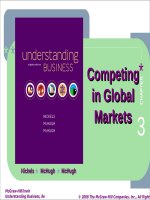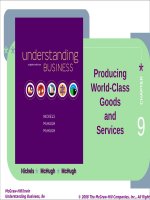Understanding business 8th by mcchugh nickels chapter 03
Bạn đang xem bản rút gọn của tài liệu. Xem và tải ngay bản đầy đủ của tài liệu tại đây (2.35 MB, 29 trang )
*
*
*
**
CHAPTER
Competing*
in Global
Markets
3
Nickels
*
McHugh
McGraw-Hill/Irwin
Understanding Business, 8e
*
McHugh
1-1
3-1
© 2008 The McGraw-Hill Companies, Inc., All Rights
*
*
*
The Dynamic Global Market
World Population by continent:
** The U.S. is the largest importing nation in the World!
3-2
*
*
*
Growing World Population
In
Billions
Source: Population Reference Bureau
3-3
*
*
*
Why Trade With
Other Nations?
• No nation can produce all
its needs
• Mutually beneficial
exchange
• Natural Resources or
Technology- Produce or
Buy?
3-4
*
*
*
Theories of Advantage
Comparativ
e
U. S.
China
China
U. S.
Output per
Unit of
Input
Softwar
e
Clothin
g
3-5
*
*
*
Theories of Advantage
Absolut = Virtual
e SouthMonopoly
Africa
Output
per Unit of
Input
The Rest of
the World
Diamond
Production
3-6
*
*
*
Global Competitiveness
Country
Strengths
United States
Technology,
R & D Spending
Finland
Univ. Enrollment, Efficient Legal
System, Business Ethics
Taiwan
Cell-phone Ownership,
Tech. Innovation,
Local Firms Competitiveness
Singapore
Savings Rate, Math/Science
Education, Political Trust
Sweden
H.S. Enrollment, Press Freedom,
Phone Access
3-7
*
*
*
Global Trade
• Goods & Services
• Importing
• Exporting
• Measuring Trade
• Balance of Trade/Payments
• Trade Deficit
• Dumping
3-8
*
*
*
U. S. Trade in
Goods & Services (Billions)
Balance of
Trade
Source: St. Louis Business Monthly, Oct. 1999 & World Trade Organization & Wikipedia
3-9
*
*
*
Leading Goods
Exporters/Importers
In Billions $
Country
United States
Germany
Japan
France
United Kingdom
World Total
Source: Wikipedia, 2005
Exports
928
1016
539
443
374
9,099
Imports
1,476
717
402
420
439
8,823
3-10
*
*
*
Strategies for
Reaching Global Markets
•
Licensing
•
Exporting
•
Franchising
•
Contract
Manufacturing
•
Joint Ventures
•
Joint Ventures &
Strategic Alliances
•
Foreign Direct
Investment
3-11
*
*
*
Country Presence
of Well-Known Companies
Source: World Features Syndicate
3-12
*
*
*
Starbucks’ Expansion
World Locations
Source: Starbucks.com May 2006
3-13
*
*
*
Most Spoken Languages
Most Spoken
Languages
in the U.S.
Most Spoken
Languages
in the World
Source: 2005 CIA World Factbook
3-14
*
*
*
Foreign Direct
Investments in the U.S.
Source: Bureau of Economic Analysis, 2004
3-15
*
*
*
World’s Largest MNCs
1) Wal-Mart Stores
2) Exxon Mobil
3) General Motors
4) BP
5) Ford Motor
6) Daimler Chrysler
7) Royal Dutch/Shell
8) General Electric
9) Toyota Motor
10)Mitsubishi
Revenue ($Billions)
217
213
175
174
162
136
135
125
121
112
Source: Business Week; Morgan Stanley Capital International; and S&P Compustat
3-16
*
*
*
What’s On Your Pizza
•
•
•
•
•
•
•
Costa Rica - Coconut
France - Bacon, onion and fresh cream
India - Pickled ginger, minced mutton and tofu
Australia - Shrimp and pineapple
Pakistan - Curry
Brazil - Green peas
Japan - Squid and mayo jaga
Source: World Features Syndicate
3-17
*
*
*
Forces Affecting Trading
in Global Markets
• Socio-cultural
• Economic & Financial
• Legal & Regulatory
• Physical & Environmental
3-18
*
*
*
Cultural Differences
in Global Markets
•
•
•
Language
Religion
Values &
Attitudes
• Social
Structure
• Aesthetics
• Personal
Communication
3-19
*
*
*
Did You Know?
•
In Turkey it’s rude to cross your arms
while you are facing someone.
•
In the Arab world the left hand is
considered unclean; don’t eat with it!
• In India never pat someone’s head,
it’s the seat of the soul.
• The Chinese associate gifts such as
straw sandals, clocks and
handkerchiefs with funerals.
3-20
*
*
*
Economic & Financial Forces
• No Worldwide Currency
• Currency Fluctuations
• Floating Exchange Rates
• Bartering/Countertrading
3-21
*
*
*
U.S. Oil Imports
Source: Gibson Consulting 2005
3-22
*
Nations That Have Not
*
* Converted to the Metric System
United
States
Liberi
a
Source: 2005 Yourunits.com
Myanma
r
(Burma)
3-23
*
*
*
Legal & Regulatory
Forces
1. Inconsistent Laws &
Regulations
2. Foreign Corrupt
Practices Act of 1978
3. Local Business Contact
Required
3-24
*
*
*
Developing Countries
Need Infrastructure
• 1.2 billion people lack clean
drinking water
• 2 billion people
lack electricity
• 3 billion people lack adequate
sanitation
3-25









